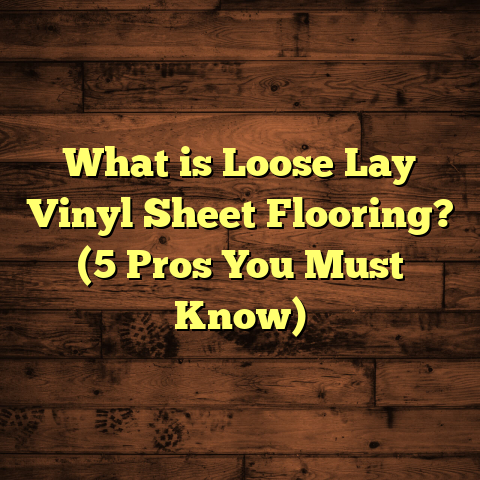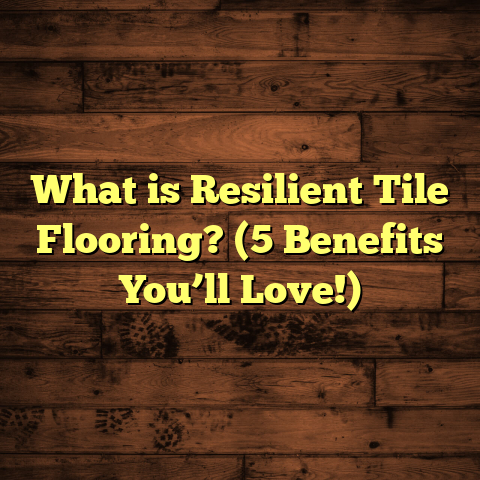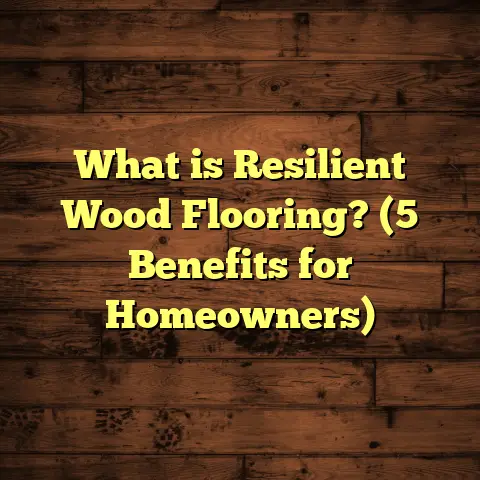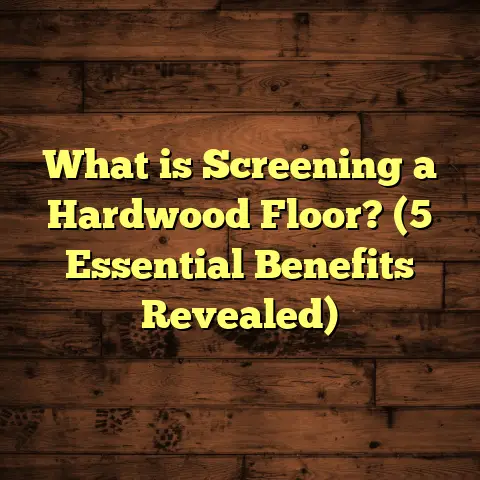What is a Hard Floor Surface? (5 Benefits You Didn’t Know)
I have to admit, one of the reasons I love hard floor surfaces is how easy they are to clean. Unlike carpet that traps dust and crumbs, a simple sweep or mop keeps a hard floor looking fresh in minutes. That’s a game-changer for busy households or anyone who hates spending hours scrubbing. But what exactly is a hard floor surface, and why do so many people, including myself, prefer it? Let me break it down for you.
What is a Hard Floor Surface?
At its core, a hard floor surface is any flooring material that is solid and durable, often made from wood, stone, tile, or synthetic materials like vinyl. Unlike soft flooring options such as carpet or rugs, hard floors have a firm feel underfoot and are generally easier to maintain. These surfaces can vary widely—from sleek hardwood planks to rustic natural stone tiles—but what they all share is their resilience and longevity.
When I first started working with floors, I was surprised at how many types of hard surfaces there are. Hardwood, ceramic tile, laminate, vinyl, stone—they all have their own personality and benefits. What’s more, these floors tend to increase the value of a home because of their durability and timeless appeal.
Personal Experience: The First Time I Installed Hardwood
I remember installing my first hardwood floor years ago. It was in my own house. The process was rewarding but meticulous—measuring twice, cutting precisely, and fitting each plank snugly. After the installation, I noticed how much cleaner the space felt; no fibers to trap dirt or allergens. Over time, I also realized how much easier it was to keep clean compared to carpeted rooms I had before.
5 Benefits of Hard Floor Surfaces You Might Not Know
Everyone talks about durability and style, but here are five benefits of hard floors that even some flooring pros might overlook.
1. Improved Indoor Air Quality
Did you know that hard floors can actually help improve the air you breathe indoors? Soft surfaces like carpets tend to trap dust mites, pet dander, and other allergens. According to the Asthma and Allergy Foundation of America, homes with hard floors have significantly lower allergen levels compared to those with wall-to-wall carpeting. For families with allergy sufferers or pets, this can make a huge difference.
In my experience, clients who switched from carpet to hard floors often report fewer allergy flare-ups. One family I worked with noticed their child’s asthma symptoms improved within weeks after replacing carpeted rooms with bamboo flooring.
But it’s not just about allergies. Hard floors don’t hold onto moisture as carpets do, which means they are less prone to mold growth. This can be especially important in humid climates or homes where spills happen frequently.
I once had a client in Florida who suffered from recurring mold problems hidden beneath old carpeting. After switching to tile floors with proper sealing, the mold was gone within months, and their indoor air quality improved noticeably.
2. Longevity That Saves Money Over Time
Hard floors might seem pricier upfront than carpet or vinyl, but they pay off in the long run. For example, hardwood floors can last over 25 years if maintained properly. Tile and stone can last even longer—sometimes decades without needing replacement.
I once helped a customer budget for their flooring using FloorTally—a tool I use regularly to estimate costs based on local labor and materials. It helped them see that investing in quality hardwood was more economical over 10 years compared to cheaper options that would need replacing every few years.
Here’s a quick breakdown of typical lifespans:
| Flooring Type | Average Lifespan |
|---|---|
| Hardwood | 25-100+ years (with refinishing) |
| Tile (ceramic/porcelain) | 50+ years |
| Vinyl | 10-20 years |
| Carpet | 5-10 years |
You can see how choosing a hard floor surface can save money over time even if the initial cost is higher.
How Maintenance Affects Longevity
I always tell clients that maintenance plays a huge role in how long their floor lasts. Hardwood floors need occasional refinishing every 7-10 years depending on traffic. Tile grout needs resealing every few years to prevent staining and water damage. Vinyl floors require less upkeep but can crack if exposed to heavy impact.
For example, I installed hardwood floors in an older home renovation where the owners were motivated by both aesthetics and durability. We discussed upfront how regular cleaning with non-abrasive products and refinishing would keep their floors looking great for decades.
Personal Story: A Floor That Lasted Generations
One of my favorite projects was restoring an old farmhouse where the original hardwood floors were still intact after nearly 80 years. The previous owners took good care of them by cleaning gently and refinishing when necessary. With just some sanding and re-staining, I brought those floors back to life—they looked better than new.
This experience showed me how hard floors can truly become family heirlooms if treated well.
3. Versatility with Design Styles
Hard floors offer incredible flexibility for decorating. Whether you’re into modern minimalism or rustic farmhouse vibes, there’s a hard floor material that fits your style perfectly. I’ve installed oak in traditional homes and sleek porcelain tiles in contemporary lofts—it’s amazing how changing the floor can redefine an entire space.
Plus, hard floors come in countless colors, textures, and finishes. This variety lets you get creative without sacrificing durability or ease of maintenance.
Here’s a quick look at popular hard floor materials and design vibes they bring:
- Hardwood: Warmth and natural beauty; fits classic to modern styles.
- Bamboo: Eco-friendly with a unique grain pattern; great for eco-conscious designs.
- Porcelain/Ceramic Tile: Sleek and versatile; available in stone-look or colorful patterns.
- Natural Stone (marble, slate): Luxurious and timeless; ideal for high-end designs.
- Laminate: Affordable imitation of wood or stone; good for renters or budget projects.
- Vinyl Plank: Durable and water-resistant; perfect for kitchens and bathrooms.
Mixing Materials for Impact
Sometimes I recommend mixing hard floor types within one space for visual interest—for instance, porcelain tile in entryways or kitchens paired with hardwood in living areas. It creates zones without losing cohesion.
One client wanted a Scandinavian feel with light oak floors but also needed waterproof flooring near their kitchen island. We installed waterproof vinyl plank in that section seamlessly transitioning into hardwood.
The Texture Factor
Texture adds another layer to design choices. Matte finishes hide scratches better than glossy ones while hand-scraped or distressed hardwood adds character compared to smooth polished surfaces.
When we installed wire-brushed oak flooring for a couple wanting a rustic-modern look, it gave their home warmth without feeling too formal.
Color Trends in Hard Flooring
Colors can influence room mood dramatically. Lighter wood tones like maple or ash brighten spaces and make rooms appear larger. Darker woods like walnut or mahogany add coziness but show dust more easily.
Right now, I’m seeing lots of interest in gray-toned hardwoods—they work well with neutral palettes and modern furniture styles.
Personal Tip: Sampling Before Committing
I always suggest getting samples or ordering small quantities first so you can see how lighting affects color before making decisions.
4. Eco-Friendly Choices Are Available
More people are thinking about sustainability when choosing flooring. Many hard floor options are surprisingly eco-friendly. Bamboo, for instance, grows quickly and is renewable. Cork is harvested without killing trees. Even reclaimed hardwood gives old wood new life instead of ending up in landfills.
I encourage clients to consider these options if they want greener homes. One project I worked on used reclaimed hardwood from old barns—it added character and reduced environmental impact.
Bamboo: The Fast-Growing Alternative
Bamboo can mature in as little as five years compared to decades for most hardwoods. It’s incredibly strong and resistant to moisture when properly treated.
I installed bamboo flooring in a young couple’s home who were concerned about deforestation but didn’t want to sacrifice style or durability.
Cork: Comfort Meets Sustainability
Cork comes from the bark of cork oak trees which regenerate after harvesting, making it highly renewable. It’s softer underfoot than other hard surfaces and provides natural insulation.
In an office space renovation I did recently, cork flooring was chosen for its eco-friendliness and noise reduction qualities.
Reclaimed Wood: History Underfoot
Reclaimed wood flooring has a story behind each plank—salvaged from old barns, factories, or warehouses. It’s often more stable than fresh-cut wood because it has already dried out thoroughly.
One homeowner loved the idea of having floors with history; we sourced wood from an old cotton mill nearby which gave their living room an authentic vintage vibe.
Certifications Matter
If sustainability matters to you, look for certifications like FSC (Forest Stewardship Council) which verify responsible forestry practices or FloorScore which ensures low VOC emissions.
5. Easy to Upgrade or Refinish
Unlike carpet or vinyl that usually need complete replacement when worn out, many hard floors can be refinished or repaired. Hardwood floors can be sanded and refinished multiple times to look brand new. Tile grout can be cleaned and resealed to freshen up the floor’s appearance.
This ease of upgrading means less waste and less cost over time.
Refinishing Hardwood Floors
Refinishing involves sanding off the top layer of wood and applying new stain or sealant. Most hardwoods can be refinished 3-5 times depending on thickness.
I helped a family whose kids had scratched their cherry wood floors badly; we refinished instead of replacing which saved thousands of dollars.
Repairing Tile Floors
Tiles rarely crack but grout often gets dirty or damaged first. Regrouting is an affordable way to make tile floors look new again without ripping them out.
In one case study from a hotel renovation I was involved with, regrouting old ceramic tiles extended the life of the lobby floor by several years while reducing renovation costs significantly.
When Replacement Is Necessary
Sometimes damage is beyond repair—like water damage warping wood boards—or style changes call for new looks entirely. Even then, hard floors often allow partial replacement of boards or tiles without replacing whole rooms.
How I Use Tools Like FloorTally for Accurate Cost Estimates
Budgeting for flooring can get complicated fast—there’s material costs, labor, waste factors, and more. FloorTally has been a lifesaver for me when planning projects. It lets me input exact room dimensions, select specific materials, and factor in local labor rates for precise estimates.
This helps me give clients realistic budgets upfront and avoid surprises later on. It also lets me compare different flooring types side-by-side so we can pick the best fit for style and price.
On one recent project with a vintage home restoration, using FloorTally helped us decide between reclaimed hardwood and porcelain tile by showing total costs including installation and waste allowance.
Why Waste Factors Matter
FloorTally includes waste percentages based on material type—usually between 5-10% for tile due to cutting losses—and this helps avoid last-minute purchases that drive up cost unexpectedly.
Saving Time on Quotes
Instead of calling multiple suppliers or installers for quotes separately—which can take days—I use FloorTally’s database of local labor rates combined with materials pricing all in one place.
This has sped up my workflow significantly while improving accuracy.
More Data You Might Find Interesting
- According to the National Wood Flooring Association (NWFA), hardwood floors increase home resale value by an average of 2-5%.
- The EPA reports that homes with hard flooring have up to 30% fewer airborne allergens than homes with wall-to-wall carpeting.
- A study published in the Journal of Environmental Health found that vinyl flooring releases fewer volatile organic compounds (VOCs) today due to stricter regulations.
- The cost of hardwood flooring installation averages between $6-$12 per square foot nationwide but varies depending on species and region.
- Tile floors can last 50+ years with proper care—much longer than carpet’s typical lifespan of 5-10 years.
- Bamboo forests absorb CO2 at roughly twice the rate of equivalent hardwood forests.
- The global market for sustainable flooring materials is growing by approximately 8% annually reflecting rising demand for green building options.
- Over 60% of homeowners prefer floors that can be refinished rather than replaced entirely due to environmental concerns.
More Stories From My Flooring Adventures
There was this one time when a client wanted marble flooring but was worried about slipping hazards because they had elderly parents at home. We chose honed finish marble instead of polished for better grip without compromising elegance.
Another memorable project involved installing radiant heating beneath porcelain tile in a mountain cabin—hard floors kept heat efficient while resisting snow melt water from boots coming inside.
And then there was the customer who wanted something pet-friendly—scratch-resistant vinyl plank worked perfectly as it could handle dog nails without damage unlike traditional hardwoods they’d considered initially.
Frequently Asked Questions About Hard Floors
Q: Are hard floors noisy?
A: They can be if not paired with rugs or soundproofing underlayment. Using area rugs or cork underlayment reduces echo significantly.
Q: Can hard floors get cold?
A: Yes, especially tile or stone in winter months—but radiant heating systems solve this easily if budget allows.
Q: How do I keep my hardwood floor scratch-free?
A: Use felt pads on furniture legs, avoid high heels indoors, clean regularly to remove grit particles which cause scratches.
Q: Is installation difficult?
A: Some types like laminate have DIY-friendly click-lock systems; others like tile require professional skill to avoid uneven surfaces or cracking later.
Q: What’s the best choice for kitchens?
A: Water-resistant options like vinyl plank or porcelain tile are ideal; hardwood works too if sealed well but needs more care around spills.
Final Thoughts on Hard Floors
Choosing a hard floor surface means balancing style, function, budget, and lifestyle needs—and that’s why I find this topic so fascinating after years working as a contractor. The combination of beauty and practicality makes them stand out as an excellent choice for most homes.
Whatever your preference—warm wood grain or cool marble sheen—there’s likely a hard floor material ready to suit your taste while making cleaning easier and improving your home environment overall.
If you ever feel overwhelmed trying to figure out costs or options, tools like FloorTally really help take guesswork out by giving detailed estimates tailored exactly to your project details.
Would you consider switching your carpeted rooms to hard floors? Or maybe upgrading your current surface? Feel free to ask if you want advice specific to your space—I’m always happy to share what I’ve learned along the way!





